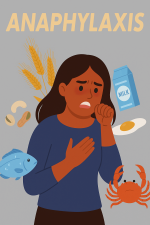
What Is Anaphylaxis?
Recognizing the Symptoms
What Is Anaphylaxis?
Anaphylaxis is a severe, potentially life-threatening allergic reaction that occurs rapidly after exposure to an allergen. When someone with a severe allergy encounters their trigger, their immune system overreacts by releasing massive amounts of chemicals like histamine throughout the body, causing systemic inflammation and shock. This reaction typically develops within minutes to an hour of exposure and affects multiple organ systems simultaneously. Common triggers include foods (peanuts, tree nuts, shellfish, eggs, milk), medications (penicillin, aspirin), insect stings (bees, wasps), and latex. Symptoms can include difficulty breathing due to airway swelling, a drop in blood pressure leading to dizziness or loss of consciousness, widespread hives or rash, swelling of the face and throat, rapid weak pulse, nausea, and vomiting. Anaphylaxis constitutes a medical emergency requiring immediate treatment with epinephrine (typically administered via an auto-injector like an EpiPen), followed by emergency medical care. Without prompt treatment, anaphylaxis can cause cardiovascular collapse and death within minutes, making early recognition and intervention critical for survival.
Always consult your medical provider before making changes to your care plan.
Recognizing the Symptoms
Symptoms of anaphylaxis can vary but often include:
- Hives or skin rash
- Swelling of the lips, tongue, or throat
- Difficulty breathing or wheezing
- Rapid or weak pulse
- Nausea, vomiting, or diarrhea
- Dizziness or fainting
It’s crucial to note that anaphylaxis can be biphasic, meaning symptoms may return hours after the initial reaction subsides. Therefore, medical observation after treatment is essential.
Immediate Response and Treatment
The first-line treatment for anaphylaxis is the prompt administration of epinephrine via an auto-injector, such as an EpiPen. Delaying epinephrine administration can lead to worsening symptoms and increase the risk of fatality. After using epinephrine, it’s imperative to seek emergency medical care, as further treatment and monitoring may be necessary.
Proper positioning of the individual during an anaphylactic reaction can aid in maintaining blood flow and breathing. Generally, lying the person flat with legs elevated is recommended unless breathing difficulties dictate otherwise.
Prevention and Preparedness
For individuals with known severe allergies, prevention strategies include:
- Strict avoidance of known allergens
- Carrying an epinephrine auto-injector at all times
- Wearing medical identification
- Educating family, friends, and coworkers about the condition
- Developing an emergency action plan
Travelers with food allergies should be aware of local emergency numbers, as they vary by country, and consider carrying allergy alert cards in the local language to communicate their condition effectively.FoodAllergy.World
Training / Information Resources
| Resource | What it provides |
|---|---|
| EPIPEN® Official Site | Info on the EpiPen & EpiPen Jr: how to use, safety info, prescribing information, etc. epipen.com |
| Illinois Department of Public Health – Epinephrine Auto‐Injector & Anaphylaxis | Defines epinephrine as first‐line treatment, importance of prompt use, tips for patients and providers. Illinois Department of Public Health |
| Food Allergy Research & Education (FARE) | Free course “Recognizing and Responding to Anaphylaxis,” plus broader info on epinephrine options and education. FoodAllergy.org |
| Allergy & Asthma Network | Posts, guidelines, charts for dosages; what to do during and after an allergic reaction. Allergy & Asthma Network |
| ASCIA (Australia) – How to give EpiPen | Clear procedure with images/video for administration of EpiPen. Good as educational/training material. allergy.org.au |
Further Reading
- What you should know about anaphylaxis
- Food allergies: what to do if someone has an anaphylactic reaction: Excellent article by Dr. Mark Porter an UK NHS GP and columnist for The Times, that covers details of how to use EpiPens, when to use EpiPens (better to give it when it is not needed ), when/why to use a second EpiPen, what to do if you do not have an EpiPen, and to beware of apparent miraculous recovery.
- How to Properly Position a Patient Suffering Anaphylaxis While Waiting for EMS: While continuously observing the patient to determine whether a second dose of epinephrine is necessary, it is important to position them correctly to help avoid shock and ensure their breathing remains unobstructed. Video:
- Biphasic Anaphylaxis Is Difficult to Predict, Can Occur Much Later Than Initial Reaction: The reason you MUST visit the emergency department after an anaphylactic reaction — even if your symptoms subside after an injection of epinephrine — is because symptoms can recur minutes or even hours later. This is known as biphasic anaphylaxis.
- Anaphylaxis FAACTs: Summary by FARE includes links to alternatives to EpiPens and airborne exposure risk for peanuts and shellfish.
- Allergyhome.org: A guide for parents and families. Provides what to do’s If you think your child is experiencing an anaphylactic reaction
- Understanding Infant Anaphylaxis: Severe Allergic Reactions in Babies
- Anaphylaxis Wallet Card
- Allergy and Anaphylaxis Emergency Plan
- Anaphylaxi Frequently Asked Questions Translated into 23 languages
- Epipens